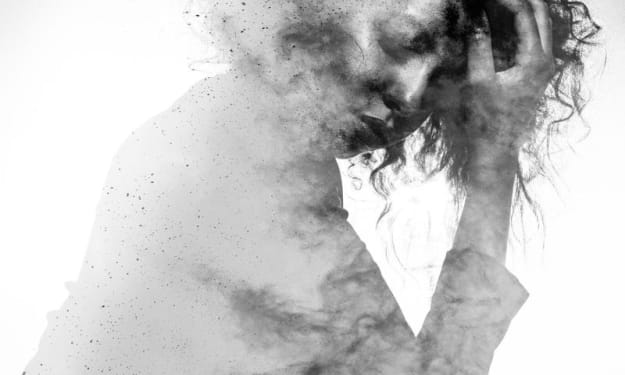One Stitch At A Time
The Healing Power of Cross Stitch

Art therapy was established in 1942 by Adrian Hill, who found painting and drawing soothing while healing from tuberculosis (Team, 2016). Since then, art therapy has grown as a profession and has been utilized in the treatment of anxiety, depression, PTSD, cancer, eating disorders, and numerous other conditions. Art therapy is no longer limited to only painting or drawing as various other forms of visual art are utilized in this form of therapy – such as sculpting or collage making. The beauty about art therapy is that it allows individuals to express themselves in a non-verbal format, and the process of creating art has a soothing effect.
Throughout my personal healing, I found art therapy to be effective in helping me to soothe my anxiety and impulses, while also helping me to express emotions that I couldn’t verbalize. I have always been an artistic individual, and I found respite in drawing and painting to help me work through my emotions.
As I progressed through my recovery of Major Depressive Disorder, Complex PTSD, and Quiet Borderline Personality Disorder, I discovered that I also suffer from a form of Obsessive Compulsive Disorder (OCD), which goes hand in hand with my anxiety. I am often disturbed by intrusive sexually explicit or violent imagery, and I have to actively push the imagery out of my mind. The way I have adapted to dealing with these images is to count the syllables I hear in dialogue on the radio or TV to help me push the imagery away; however, I also experience jitters and dread when the syllables I count end on an odd number. Throughout my life I thought that everyone experienced this same phenomenon, and it was only through therapy that I realized that it is a product of mental illness. This constant battle in my mind prohibits me from being able to watch TV or listen to the radio without doing something else while I am watching or listening, such as performing a craft. The jitters I feel as a product of the intrusive imagery in my mind become so intense that I can’t sit still and I can’t concentrate on what I am watching or listening because I become obsessed with counting syllables. My mind is often a mess, and I experience extreme fatigue from the battle I am always fighting with myself.
My obsession with counting has always been a way that I subconsciously kept my anxiety in check, and it wasn’t until I was diagnosed with OCD that I realized a way that I adapted this obsession into something productive was through my love of counted cross stitch.
Counted cross stitch, much like counting syllables, requires you to count squares on a piece of fabric according to a pattern so that you embroider the fabric in a way that creates a picture made from thread. It requires a high level of mindfulness because you need to keep your place when counting the stitches on a piece of fabric to work out the pattern. I have always loved cross stitch and practice it while watching TV or listening to the radio, but it was only through therapy that I discovered that practicing cross stitch was a subconscious way that my brain adapted my counting obsession into something productive. Instead of feeling overwhelmed and like my mind is going in circles over counting syllables, I have found that cross stitch not only helps me with my counting obsession, but it makes me feel accomplished when I complete one of my embroidered works of art.
I have used my experience with utilizing cross stitch as therapy for my OCD to help others who struggle with OCD or anxiety find respite in art therapy through the needle arts. Cross stitch is wonderful for use in the counting form of OCD, but crocheting and knitting are also effective because they require the same level of mindfulness and counting when completing a pattern. While crochet, knitting, and cross stitch are all excellent in art therapy because they providing a soothing effect, they are excellent in the treatment of OCD to help individuals deal with their impulses in a productive and positive manner.
For so long I have suffered because of the war inside of my mind that I experience from my counting OCD, but through cross stitch and the needlearts I have found a sense of purpose and accomplishment in my disorder that I never did before. Art therapy utilizing any form of art creates purpose in the midst of mental illness, and it is an affordable and accessible level of care that can be practiced alone or in a therapeutic setting.
If you suffer from any form of anxiety or stress, I challenge you to try to regularly incorporate art making of any kind into your daily routine and see what difference it makes in your life. Art therapy has been a huge factor in helping me cope with my mental illness and find purpose in my life, and I am positive that you will feel the same way. While I still struggle with my mental illnesses every day, art has made it that much easier to cope.
References
Team, G. T. E. (2016). Art Therapy. Retrieved from https://www.goodtherapy.org/learn-about-therapy/types/art-therapy.
About the Creator
Ashley Nestler, MSW
Ashley Nestler is a Bibliotherapist and a survivor of Schizoaffective Disorder, OCD, Quiet Borderline Personality, Fibromyalgia,multiple eating disorders, and C-PTSD. Ashley has dedicated her life to books and advocating for mental health.






Comments
There are no comments for this story
Be the first to respond and start the conversation.